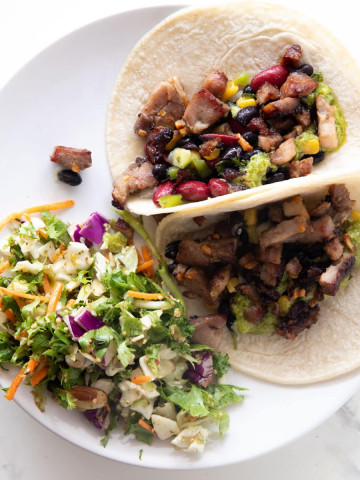Hi, friends! I can't believe it's time to wrap up this series already! A whole year? I'm already starting to think of series for next year, if you have an idea let me know! Otherwise, let's get to the last and final produce guide of the year!
This year, one of my goals is to cut down on grocery expenses by buying in-season produce. Since I’m doing the research anyway, I thought I would share it with you guys! Buying in season is more important than ever. It keeps grocery costs down and ensures food will supply the most nutrients.
For this month, be sure to also check out the November Produce Guide as well. Some of the produce for November will still be in season through December or even January. In fact, as it reaches the end of its growing season, some produce items may be priced even lower than they were at their peak as they try to sell the surplus!
Of course, what produce is in season can vary by region, so I focused on the Southwest in my research. If you are on the east coast, it should still apply, but some things vary. I also included recipes you can make with this month’s produce, so hopefully, it helps inspire your weekly menu this month!

Enjoy some fresh fall produce with some vibrant, gorgeous looking fruits and vegetables! I’ve included some of my top favorite produce items for December, as well as recipes for each one, so you can be inspired to eat healthfully this month.
Winter squash:
Squash is such a versatile vegetable to incorporate into your winter recipes. Whether it’s a sweet or savory dish, you can add winter squash to provide more flavor and texture. In case you didn’t know, winter squash is just the umbrella term for numerous types of squash — spaghetti, acorn, butternut, hubbard, acorn, and more.
Winter squash contains vitamin C, fiber, and vitamin A, and studies have shown that these veggies are a great way to include antioxidants and heart-healthy foods into your daily meals. Squash also helps to regulate blood sugar, prevent some types of cancer, and reduce the risks of heart disease. It’s a great time to purchase these seasonal products, so get them while you can! My favorite part about winter squash is that it's just something different from the regular!
Check out some of my recipes featuring winter squash:
- Paleo Sloppy Joe Stuffed Squash
- Chimichurri Squash Egg-In-A-Hole
- Chorizo Stuffed Breakfast Acorn Squash
Click Here For More Winter Squash Recipes >>
Fennel:
Fennel, also known as foeniculum vulgare, is a flavorful Mediterranean herb used to enhance a variety of dishes. Personally, I know I need to use more of this veggie in my life as it's not super familiar to me! This vegetable looks very similar to celery, but it actually consists of a bulb and seeds, which are both edible and have a licorice-like taste. Fennel is great incorporation to warm meals, such as soups, in the wintertime.
However, it can also be eaten raw when tossed into a salad. In addition to its use in the kitchen, fennel has numerous medicinal purposes that play a role in reducing inflammation, improving immunity, preventing cancers, strengthening bones, and maintaining blood pressure. These health benefits are due to the fact that fennel contains nutrients such as calcium, vitamin C, potassium, and fiber. With so many health benefits, go ahead and try it out this month!
Check out some of these recipes from other dietitians featuring fennel:
- Lebanese Wild Fennel Pesto from The Conscious Dietitian
- Simple Citrus and Fennel Salad from Dietitian Debbie
- Pear Fennel Salad with Arugula from The Plant-Powered Dietitian
Cranberries:
Many of you have seen me splashing cranberry juice in my water to ward of pregnancy-related UTI's and help me drink water (TMI?) However, cranberries (versus cranberry juice) are a very underrated fruit that can be used in so many dishes. These vibrant fruits can be used as a natural sweetener in fruit-forward desserts such as fruit bowls, muffins, sauces, and more! Although they appear small, they have mighty effects because of their nutrient-rich content and antioxidant powers.
Cranberries are low in saturated fat, cholesterol, and sodium and are a good source of fiber, vitamin C, vitamin K, and manganese. Just one handful of cranberries can help lower the risks of cancer, improve immune function, and reduce blood pressure. Enjoy them while they're in season!
Check out some of my recipes featuring cranberries:
- Healthy Cranberry Orange Muffins
- Cranberry Date Quinoa Breakfast Bars
- Easy Skinny Cranberry Cocktails or Mocktails
Click Here For More Cranberry Recipes >>
Mushrooms:
Mushrooms can be a great incorporation into numerous dishes, and since they are in season, it's a good time to try them out. There are actually numerous types of mushrooms that you can find at your local grocery store, such as portobello, shiitake, oyster, and more. My favorite is shiitake for the huge immune boosting benefits!
Mushrooms are a good source of fiber, vitamin C, vitamin D, potassium, and even protein for all my plant-based people. Still not convinced to try these vegetables? This superfood also has the ability to boost your immune system, reduce your risk of heart disease, improve your digestive system, and help maintain healthy skin.
What's not to love? You can add them to grain bowls, pastas, stir-fry, and sandwiches, so if you want to switch things up this month, check out these recipes below. (Note - Mr. Hungry has a severe sensitivity, potentially even allergic reaction to mushrooms, so they aren't in my recipes sadly, but lots of options from my RD friends!)
Check out some of these recipes from other dietitians featuring mushrooms:
- Hungarian Mushroom Soup from The Domestic Dietitian
- Portobello Mushroom Pizzas from Dietitian Debbie
- Mushroom Stroganoff from The Plant-Powered Dietitian
Mangos:
Even though it’s winter, mangos are actually the freshest during this time of year. Weird, right? I totally think of them as tropical fruit, but they are in season now! You can never go wrong with adding this tasty tropical fruit to your salads, smoothies, and oatmeal. One of my favorite things about mango is that they can be eaten at just about any time of day — breakfast, lunch, dinner, AND even dessert!
They are a great way to incorporate a natural sweetness into your dishes while also gaining tons of nutrients. Mangos are high in antioxidants, boost immunity, support digestive health, lower risks of certain cancers, and improve skin and hair health. These numerous health benefits are a result of the nutrients that mangos provide, which includes fiber, vitamin C, vitamin A, and vitamin E. So what are you waiting for? Go grab some mangos while they’re in season!
Check out some of these recipes from me and other dietitians featuring mangos:
- Peach Mango Smoothie
- Mango Salsa from Nutrition Savvy Dietitian
- Mango Chicken Salad with Avocado from The Real Food Dietitians
Tangerines:
Did you know that tangerines (and citrus fruits in general) are actually the freshest during the wintertime? This is the time that they are loaded up at your local grocery store, so definitely go and grab a few today! Tangerines are my favorite snacks to enjoy on warm and sunny days (aka all days in Arizona.)
Tangerines are super portable due to their smaller size. Not only can tangerines be eaten as a snack, but these fresh, juicy fruits provide a sweet-tangy flavor that can be used in a variety of sweet and savory dishes. They can be added to salads, mixed into your stir-fry, used as a sauce, and whipped up in a sorbet.
Similar to oranges, tangerines are antioxidants that are very good sources of vitamin A and vitamin C, and they are also high in fiber. This nutrient-rich fruit supports heart health, contains detoxifying abilities, prevents diseases, and supports a healthy digestive system. Interestingly enough, studies have shown that tangerines can also play a role in reducing stress and anxiety, which helps to improve your overall mood.
Check out some of these recipes from other dietitians featuring tangerines:
- Tangerine Strawberry Creamsicle Smoothie from Nutrition a la Natalie
- Tangerine Chicken Skewers from The Nutrition Twins
- Kale, Green Bean, White Bean and Tangerine Salad from Tasty Balance Nutrition












paper writer says
Oranges are my fav winter fruit.